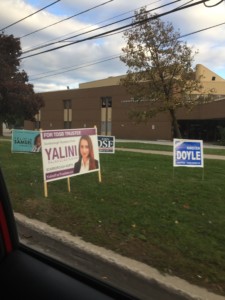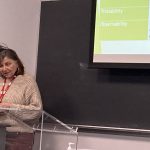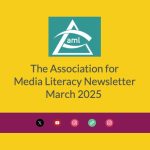Election Signs – Easy & Timely Lessons for Elementary*
*Diana Maliszewski’s 2019 Elementary lesson on Elections – their signs and processes – is well worth reviving for a 2022 Fall activity!
Elections are great opportunities for students to examine a particular media text that often accompanies these events – the election sign. Diana Maliszewski suggests that these questions and activities can work well for Grade 5 students who may be simultaneously working on their social studies unit (People and Environments: The Role of Government and Responsible Citizenship) but can be applicable to all grades in an elementary school.
Below are some tasks, some discussion questions, connected areas of the curriculum and a few tips to help educators facilitate the talks.

Possible Tasks
- Possibly begin with a discussion about signs, especially in a residential community. What kinds of signs might students see regularly? What signs do they see now (or during an election season)?
- Take a walk around the community. How many different kinds of signs do they see? How many appear on one individual house lawn? (Why might that be?) How many signs do they see on public spots (like street corners)? Why might there be a different number of signs on public street corners than on house or apartment building lawns?
- Tally the number of signs and/or the signs for specific candidates. What do the numbers suggest?
- Take photos of some of the election signs, or call some of the candidates to ask for signs to use to examine for class discussion. (How easy is it to contact candidates?)
- Sort the signs by different categories. What categories do the students use? What categories do they not use?
- Research how much it costs to produce election signs. How many signs do candidates order? How much does it cost? How do they pay for the signs?
- If time, collect and compare election flyers to election signs. How are they similar? How do they differ?
- Pay special attention to any desecrated or vandalized signs. How were they ruined? Who might have done it? Why?
- Make your own election sign. What colours did you choose? What font did you select? Did you include a photo of yourself? Did you include a slogan or catchphrase?
Possible Questions
- What colours are used most frequently on election signs? Why?
- What words are used most frequently on election signs? What is the average word count on an election sign? Why?
- How frequently do visuals appear on election signs? What kind of visuals are used? How are people dressed if/when they appear on election signs? Where are the visuals placed? (Left side? Right side? Centre? Does it matter?)
- Who is the target audience for these signs? How can you tell? What happens when we drive from one end of the city to another?
- How do candidates choose to represent themselves?
- How many candidates are running in this election? How many have signs? Why might these two numbers not be the same?
- How many men are running for political office? How many women? What different cultures, nationalities, or ethnic groups are represented via the candidates? Does it match the general population of the area? What might it matter? Who is not represented? Why might this matter?
Ontario Curriculum Connections
Language – Media Literacy – Understanding Media Texts – Purpose and Audience
e.g. Grade 6, 1.1. “explain how a variety of media texts address their intended purpose and audience”
Language – Media Literacy – Understanding Media Texts – Making Inferences / Interpreting Messages
e.g. Grade 2, 1.2 “identify overt and implied messages in simple media texts”
Language – Media Literacy – Understanding Media Texts – Production Perspectives
e.g. Grade 8, 1.6 “identify who produces various media texts and determine the commercial, ideological, political, cultural, and/or artistic interests or perspectives that the texts may involve
Language – Media Literacy – Understanding Media Forms, Conventions, and Techniques
e.g. Grade 4, 2.2 “identify the conventions and techniques used in some familiar media forms and explain how they help convey meaning”
Social Studies – People and Environments
e.g. Grade 1, B3.7 “identify some of the services in the community for which the government is responsible”
e.g. Grade 3, B3.1 “demonstrate an understanding that Ontario is divided into different municipal or regional entities and that local governments withing these entities provide specific services and regulate development according to local needs”
e.g. Grade 5, B3.2 “describe the jurisdiction of different levels of government in Canada and some of the services provided by each”
Teacher Tips
- In English, readers will often skim a page in a Z format, starting from the upper left corner, looking across the top, then diagonal to the lower left corner and finally ending at the lower right corner (see Media Studies K-12, a 2005 TDSB document)
- Colour choices are often dictated by where on the political spectrum a political party lies (see https://www.wou.edu/wp/exhibits/files/2015/07/politics.pdf for a broad, multi-country explanation of different colours) For a different perspective, peek at this colour psychology website (see https://www.empower-yourself-with-color-psychology.com/meaning-of-colors.html)
- Politics still remains a predominantly male profession. This article by “Women in Cities International” maps the urban/rural, male/female results at the federal level (see https://femmesetvilles.org/female-representation-in-canadas-parliament-the-rural-urban-divide-from-2006-to-2015/) Clothing choices often lean towards masculine and power (e.g. suits, collars, etc.)
- Search online (using terms such as “candidates in my area”, or “[date] municipal/provincial/federal election candidates”) for lists. Remember that algorithms impact what results you see first when using search engines.
–First published Fall, 2019; Updated August 2021–



